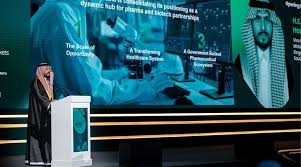Decoding Saudi Arabia’s Pharma Metamorphosis via Vision 2030 and CPHI
Forging a New Dawn: Vision 2030’s Bold Blueprint for Pharmaceutical Empowerment
Saudi Arabia’s Vision 2030 stands as a transformative force, propelling the nation toward economic diversification and self-reliance. Crown Prince Mohammed bin Salman unveiled this ambitious initiative in 2016, aiming to reduce oil dependency by fostering vibrant sectors like healthcare and pharmaceuticals. At its core, Vision 2030 allocates substantial investments—exceeding $65 billion—to overhaul the healthcare infrastructure, thereby catalyzing local manufacturing and innovation. This strategic pivot not only enhances public health outcomes but also positions the Kingdom as a global contender in the pharmaceutical arena. Consequently, pharmaceutical companies worldwide now eye Saudi Arabia as a hub of opportunity, where regulatory reforms and incentives accelerate market entry and growth.
Moreover, Vision 2030 emphasizes localization, urging the development of domestic production capabilities to meet rising demand. The government actively supports this through initiatives like the National Biotechnology Strategy, which seeks to establish Saudi Arabia as a regional biotech powerhouse. For instance, partnerships with international firms enable the transfer of advanced technologies, from biopharmaceuticals to nanomedicines. As a result, the pharmaceutical market in Saudi Arabia projects exponential growth, potentially reaching $15 billion by 2028. This momentum underscores a shift from import reliance to indigenous innovation, ensuring that the sector aligns seamlessly with broader economic goals. Transitioning from these foundational strategies, recent events like CPHI Middle East 2025 illuminate how these visions materialize on the ground.
Spotlight on Synergy: CPHI Middle East 2025 Riyadh as a Catalyst for Regional Pharma Evolution
CPHI Middle East 2025 Riyadh emerged as a pivotal gathering, drawing over 38,000 attendees from more than 100 countries to the Riyadh Exhibition and Convention Centre. This landmark event, hosted from December 8 to 10, showcased over 600 exhibiting companies, fostering dialogues on cutting-edge trends and collaborative ventures. Organizers highlighted Saudi Arabia’s post-COVID recovery and economic diversification as key drivers, with the pharma sector leading the charge. Attendees witnessed firsthand how Vision 2030 integrates with global supply chains, as exhibitors unveiled solutions tailored to the Middle East’s unique needs. Thus, the conference served not merely as a trade fair but as a strategic forum where policymakers, innovators, and investors converged to shape the industry’s trajectory.
Furthermore, CPHI Middle East 2025 amplified the role of local stakeholders, including the Exhibition Company in Saudi Arabia, which expertly managed logistics and networking sessions to maximize participant engagement. Sessions delved into biologics expansion and digital health integration, revealing how Saudi firms partner with global leaders to bridge technological gaps. For example, panel discussions emphasized sustainable sourcing of raw materials, aligning with Vision 2030’s environmental imperatives. As delegates departed, they carried actionable insights that promise to redefine operational efficiencies across the region. Building on this vibrant backdrop, the event’s key takeaways offer profound lessons for stakeholders navigating the evolving pharma landscape.
Igniting Innovation: Technological Leaps and Digital Frontiers Unveiled at CPHI
Vision 2030 propels technological adoption in pharmaceuticals, and CPHI Middle East 2025 vividly demonstrated this through immersive showcases of AI-driven drug development and telemedicine platforms. Exhibitors presented AI tools that streamline clinical trials, reducing timelines by up to 30% and enhancing precision in personalized medicine. Saudi regulatory bodies actively endorse such advancements, offering streamlined approvals to incentivize R&D investments. Consequently, local startups collaborate with international giants, birthing hybrid solutions that address chronic diseases prevalent in the Gulf region. This fusion of technology not only boosts efficiency but also democratizes access to advanced therapies, fulfilling Vision 2030’s accessibility mandate.
In addition, digital transformation dominated conference agendas, with speakers advocating blockchain for supply chain transparency and predictive analytics for demand forecasting. One notable session featured a Saudi biotech firm unveiling a cloud-based platform that integrates electronic health records with real-time genomic sequencing. Attendees praised how these innovations mitigate counterfeit drugs, a persistent challenge in emerging markets. Therefore, as Vision 2030 allocates over $50 billion to digital health in recent years, events like CPHI underscore the tangible progress, empowering pharma leaders to scale operations sustainably. These technological strides seamlessly transition into broader sustainability efforts, where environmental stewardship meets economic ambition.
Embracing Equilibrium: Sustainability and Localization as Pillars of Pharma Resilience
Sustainability emerged as a cornerstone at CPHI Middle East 2025, where Vision 2030’s green initiatives intersect with pharmaceutical imperatives. Exhibitors showcased eco-friendly manufacturing processes, including biodegradable packaging and water-efficient production lines, aligning with the Kingdom’s commitment to net-zero emissions by 2060. Saudi authorities incentivize these practices through tax rebates and grants, compelling global suppliers to adapt their strategies for regional compliance. As a result, the sector witnesses a surge in circular economy models, where waste from one process fuels innovation in another. This proactive approach not only curtails environmental impact but also fortifies supply chain resilience against global disruptions.
Moreover, localization strategies took center stage, with discussions on bolstering domestic API production to achieve 40% self-sufficiency by 2030. CPHI facilitated B2B matchmaking that linked Saudi manufacturers with European technology providers, fostering joint ventures in sterile injectables and generics. For instance, a Riyadh-based facility announced expansions funded by Vision 2030’s industrial clusters, creating thousands of skilled jobs. Thus, these efforts cultivate a robust ecosystem, reducing import costs and enhancing national security in healthcare. Transitioning forward, such localization paves the way for a forward-looking vision that anticipates global shifts in the pharma paradigm.
Charting the Course Ahead: Strategic Imperatives and Global Ramifications
Looking beyond the exhibition halls, CPHI Middle East 2025 reinforced Vision 2030’s role in positioning Saudi Arabia as a pharma export powerhouse. Analysts predict that strategic investments will elevate the Kingdom’s market share in the Middle East and Africa, with exports targeting high-growth areas like oncology and rare diseases. Policymakers outlined roadmaps for harmonizing regulations with international standards, easing cross-border collaborations. Consequently, multinational corporations accelerate their footprints in the Kingdom, establishing R&D centers that blend local talent with global expertise. This outward orientation not only diversifies revenue streams but also amplifies Saudi influence in shaping global health policies.
In parallel, the event spotlighted workforce development, with Vision 2030’s emphasis on upskilling yielding programs that train over 10,000 pharma professionals annually. Interactive workshops at CPHI equipped participants with competencies in regulatory affairs and sustainable design, ensuring a talent pipeline ready for tomorrow’s challenges. However, stakeholders must address hurdles like intellectual property frameworks to sustain momentum. Ultimately, as Saudi Arabia navigates these dynamics, it exemplifies how visionary governance ignites sectoral renaissance, inviting the world to partake in this pharma odyssey. With these insights, industry pioneers stand poised to harness Vision 2030’s momentum, crafting a healthier, more innovative future.
In conclusion, Saudi Arabia’s Vision 2030, illuminated through the lens of CPHI Middle East 2025, heralds an era of unparalleled transformation in the pharmaceutical domain. By intertwining bold investments, technological prowess, and sustainable ethos, the Kingdom redefines regional leadership. Stakeholders who embrace these takeaways will not only thrive amid change but also contribute to a legacy of progress that echoes far beyond 2030. As the pharma landscape continues to evolve, Saudi Arabia’s journey offers a blueprint for nations aspiring to blend ambition with action.












